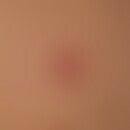Synonym(s)
HistoryThis section has been translated automatically.
Vogt, 1906; Harada, 1926; Koyanagi, 1929. In 1906 Vogt and in 1929 independently Koyanagi described a disease characterized by chronic anterior uveitis, alopecia, vitiligo and dysacusis. In 1929, Harada described a disease characterized by bilateral serous retinal detachment, chronic posterior uveitis and cerebrospinal fluid pleocytosis. It was later recognized that these anterior and posterior segment inflammations were manifestations of one and the same disease process, and the disease was named Vogt-Koyanagi-Harada disease (VKH).
DefinitionThis section has been translated automatically.
Vogt-Koyanagi-Harada disease is a well-defined disease that classically follows an evolutionary course. The disease begins with a prodromal phase characterized by a "flu-like" illness, headache and meningismus, followed by bilateral choroiditis with serous retinal detachments (early stage of the disease, formerly referred to as "acute"). They are usually multiple detachments with multiple early punctate leaks and late dye accumulation on fluorescein angiogram; occasionally they may develop into bullous detachments. Although the detachments may resolve spontaneously, the disease typically progresses to chronic anterior uveitis or panuveitis if untreated. The early stage is often, though not always, accompanied by neurological symptoms such as tinnitus and dysacusis; lumbar puncture reveals pleocytosis of the cerebrospinal fluid. A few months after the onset of the disease, the late stage (formerly referred to as "chronic") appears with a "sunset glow" fundus, often with peripapillary atrophy, foveal granular pigment deposits and peripheral, depigmented, atrophic chorioretinal patches, typically in the lower periphery. Late-stage active disease presents with chronic anterior uveitis or panuveitis with inflammatory lesions of the choroid similar to those seen in sympathetic ophthalmia, sometimes referred to as "Dalen-Fuchs-like nodules". In the late stages of the disease, skin changes may also occur (symmetrical -segmental- vitiligo in 60%; poliosis in 80% - mostly eyebrows and eyelashes( and hair changes (in >50% of cases: alopecia areata).
You might also be interested in
Occurrence/EpidemiologyThis section has been translated automatically.
Rare. Vogt-Koyanagi-Harada disease is most common in people of East or South Asian descent, but is also common in the Middle East. In Japan, VKH is the most common uveitic disease seen in tertiary care ophthalmology referral clinics. In the United States, it is most commonly diagnosed in individuals of Hispanic or Native American descent. The HLA-DR4 genotype is a risk factor, especially HLA-DRB1*0405.9
EtiopathogenesisThis section has been translated automatically.
Unknown. Autoimmune reactions after viral infections are discussed, whereby a T-cell-mediated reaction against melanocytes in the skin, eye and inner ear occurs. Tyrosinase and TRP1 are regarded as possible allergens.
ManifestationThis section has been translated automatically.
ClinicThis section has been translated automatically.
Skin changes: In the late stage of the disease, skin changes may occur (symmetrical -segmental vitiligo in 60%; poliosis in 80% - mostly eyebrows and eyelashes (and hair changes (in >50% of cases: alopecia areata).
Progression/forecastThis section has been translated automatically.
LiteratureThis section has been translated automatically.
- Harada E (1926) Contributions to the clinical nucleitis of non-purulent choroiditis. Nippon Ganka Gakkai Zasshi 30: 356-361
- Koyanagi Y (1929) Dysacusis, alopecia and poliosis in severe uveitis of non-traumatic origin. Klin Monatsbl Augenheilk (Stuttgart) 82: 194-211
- Read RW (2002) Vogt-Koyanagi-Harada disease. Ophthalmol Clin North Am 15: 333-341
- Vogt A (1906) Premature graying of the cilia and remarks on the so-called sudden onset of this change. Klin Monatsbl Augenheilk (Stuttgart) 44: 228-242
- Okamoto Y et al. (2004) Delayed regeneration of foveal cone photopigments in vogt-koyanagi-harada disease at the convalescent stage. Invest Ophthalmol Vis Sci 45: 318-322
Standardization of Uveitis Nomenclature (SUN) Working Group (2021). Classification Criteria for Vogt-Koyanagi-Harada Disease. Am J Ophthalmol 228:205-211
Incoming links (8)
Harada disease; Harada syndrome; Oculocutaneous syndrome; Poliosis; Premature canities; Tattoo, side effects; Tyrosinase-related protein; Vogt koyanagi harada syndrome;Disclaimer
Please ask your physician for a reliable diagnosis. This website is only meant as a reference.




